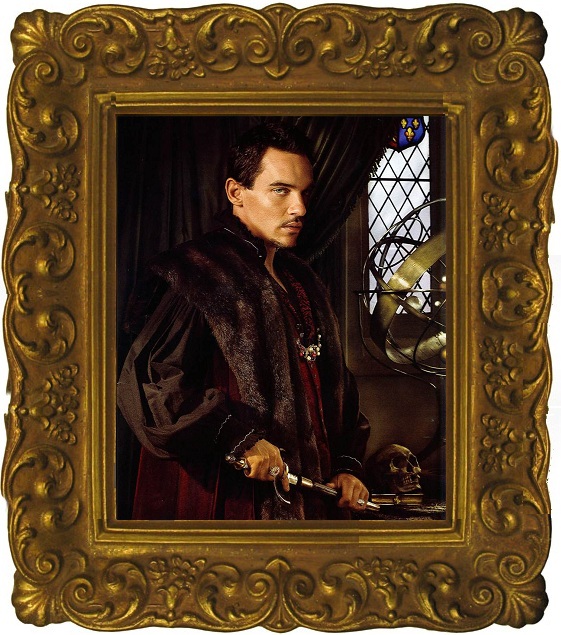 Henry VIII (28 June 1491 – 28 January 1547) was King of England from 21 April 1509 until his death. He was also Lord of Ireland (later King of Ireland) and claimant to the Kingdom of France. Henry was the second monarch of the House of Tudor, succeeding his father, Henry VII.
Henry VIII (28 June 1491 – 28 January 1547) was King of England from 21 April 1509 until his death. He was also Lord of Ireland (later King of Ireland) and claimant to the Kingdom of France. Henry was the second monarch of the House of Tudor, succeeding his father, Henry VII.
Besides his six marriages, Henry VIII is known for his role in the separation of the Church of England from the Roman Catholic Church. Henry's struggles with Rome led to the separation of the Church of England from papal authority, the Dissolution of the Monasteries, and establishing himself as the Supreme Head of the Church of England. He changed religious ceremonies and rituals and suppressed the monasteries, while remaining a believer in core Catholic theological teachings, even after his excommunication from the Roman Catholic Church. Henry also oversaw the legal union of England and Wales with the Laws in Wales Acts 1535–1542.
Henry was an attractive and charismatic man in his prime, educated and accomplished. He ruled with absolute power. His desire to provide England with a male heir—which stemmed partly from personal vanity and partly because he believed a daughter would be unable to consolidate the Tudor Dynasty and the fragile peace that existed following the Wars of the Roses—led to the two things that Henry is remembered for today: his wives, and the English Reformation that made England a Protestant nation. In later life he became morbidly obese and his health suffered; his public image is frequently depicted as one of a lustful, egotistical, harsh and insecure King.
Henry is famously remembered for having six wives—two of whom he had beheaded—which helped to make him a cultural icon, with many books, films, plays, and television series based around him and his wives.
Late in life, Henry became obese (with a waist measurement of 54 inches/137 cm) and had to be moved about with the help of mechanical inventions. He was covered with painful, puss-filled boils and possibly suffered from gout. His obesity and other medical problems can be traced from a jousting accident in 1536 in which he suffered a leg wound. The accident actually re-opened and aggravated a previous leg wound he had sustained years earlier, to the extent that his doctors found it difficult (if not impossible) to treat it. The wound festered for the remainder of his life and became ulcerated, thus preventing him from maintaining the same level of physical activity and daily exercise that he had previously enjoyed. The jousting accident is also believed to have caused in Henry mood swings, which may have had a dramatic effect on his personality and temperament. Concurrently, Henry also developed a binge-eating habit, consisting of a diet of mainly fatty red meats and few vegetables. It is believed that this habit was used as a coping mechanism for stress. Henry's obesity undoubtedly hastened his death at the age of 55, which occurred on 28 January 1547 in the Palace of Whitehall, on what would have been his father's 90th birthday. He expired soon after allegedly uttering these last words: "Monks! Monks! Monks!"
The theory that Henry suffered from syphilis was first promoted approximately 100 years after his death, but has been disregarded by most serious historians. Syphilis was a well-known disease in Henry's time, and although his contemporary Francis I of France was treated for it, the notes left from Henry's physicians do not indicate that the English king was. A more recent and credible theory suggests that Henry's medical symptoms, and those of his older sister Margaret Tudor, are also characteristic of untreated Type II diabetes.
Meeting of Henry VIII and MaximilianHenry VIII was buried in St George's Chapel in Windsor Castle, next to his wife Jane Seymour. Over a hundred years later Charles I was buried in the same vault.
Within a little more than a decade after his death, all three of his royal heirs sat on the English throne, and all three left no descendants. Under the Act of Succession 1543, Henry's only surviving legitimate son, Edward, inherited the Crown, becoming Edward VI. Since Edward was only nine years old at the time, he could not exercise actual power. Henry's will designated 16 executors to serve on a council of regency until Edward reached the age of 18. The executors chose Edward Seymour, 1st Earl of Hertford, Jane Seymour's elder brother, to be Lord Protector of the Realm. In default of heirs to Edward, the throne was to pass to Henry VIII's daughter by Catherine of Aragon, the Princess Mary, and her heirs. If Mary's issue also failed, the crown was to go to Henry's daughter by Anne Boleyn, Princess Elizabeth, and her heirs. Finally, if Elizabeth's line also became extinct, the crown was to be inherited by the descendants of Henry VIII's deceased younger sister, Mary. The descendants of Henry's sister Margaret Tudor—the royal family of Scotland—were therefore excluded from succession according to this act. This final provision failed when James VI of Scotland subsequently became James I of England upon Elizabeth's death.